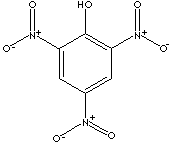|
Picric acid, 2,4,6-trinitrophenol, is a toxic, explosive, highly oxidative
yellow crystalline solid with bitter taste; soluble in water, alcohol,
chloroform, most organic solvents, and ether; melts at 122 C; derived from
phenol through nitration reaction or from chlorobenzene through several steps.
Picric acid itself as well as its metallic salts are highly explosive. Lyddite
and melinite, high explosives, are composed mostly of compressed or fused picric
acid. It is also used as a booster for other explosives and rocket fuel. It
should be transported with 30% or more water. In addition to pyrotechnic application, picric acid
is used to make dyes (yellow color), antiseptic agents,
external medicines, insecticides (chloropicrin, nitrotrichloromethane),
batteries and etching copper as well as a colorimetric reagent to determine
creatinine. |
